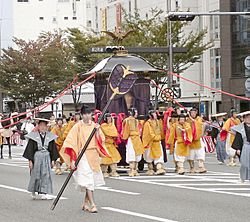Jidai Matsuri facts for kids
Quick facts for kids Jidai Matsuri |
|
|---|---|
 |
|
| Also called | Jidai |
| Observed by | Kyoto, Japan |
| Type | Religious |
| Date | 22 October |
| Next time | 22 October 2025 |
| First time | 1895 - (130 years, 7 months and 7 days) |
| Related to | Fukagawa Matsuri, Sannō Matsuri |
The Jidai Matsuri (時代祭), which means "Festival of the Ages," is a famous Japanese festival, or matsuri. It takes place every year on October 22 in the city of Kyoto, Japan. It is one of the three most important festivals in Kyoto. The other two are the Aoi Matsuri in May and the Gion Matsuri in July.
The Jidai Matsuri is famous for its large parade. People of all ages dress up in amazing, authentic costumes from different times in Japanese history. This type of parade is called a historical reenactment, and it shows what life was like in Japan long ago.
Contents
History of the Festival
The story of the Jidai Matsuri begins in 1868, a time known as the Meiji Restoration. This was a period of big changes in Japan. The capital city was moved from Kyoto to Tokyo. This meant the Emperor of Japan, his family, and many government workers all moved to the new capital.
The people of Kyoto were worried. They feared their city would be forgotten and lose its importance. To celebrate Kyoto's long and amazing history, the city government decided to create a new festival.
Celebrating Kyoto's Founding
The first Jidai Matsuri was held in 1895. This was the 1100th anniversary of when Kyoto was founded in the year 794. Back then, Kyoto was called Heian-kyō. It was founded by Emperor Kanmu (桓武天皇, Kanmu-tennō).
To prepare for the festival, the city built the beautiful Heian Shrine (平安神宮, Heian jingū). This shrine was made to honor the spirit of Emperor Kanmu. The main event was a costume parade showing people from every era of Kyoto's history.
Honoring a Second Emperor
In 1940, the festival was expanded. It began to also honor Emperor Kōmei (孝明天皇, Kōmei-tennō). Emperor Kōmei was important because he helped unite the country. He also strengthened the power of the emperor's court at the end of the Edo period, when the rule of the shoguns was ending.
What Happens at the Jidai Matsuri?
The festival is a full day of celebration that brings history to life. It starts early in the morning at the Kyoto Imperial Palace, which was once the home of the Emperor.
Two mikoshi (portable shrines that are beautifully decorated) are brought out. One represents Emperor Kanmu, and the other represents Emperor Kōmei. People gather to see the mikoshi and pay their respects.
The Grand Parade
The main event, the costume parade, begins in the afternoon. It is a huge procession with about 2,000 performers. The parade route is two kilometers long and takes about five hours to complete!
The performers are dressed as people from different historical periods, starting from the earliest eras of Japan up to the Meiji era. You can see samurai warriors, military leaders, and regular people from long ago.
A special part of the parade features women dressed in elaborate, multi-layered kimonos called jūnihitoe (十二単衣, juunihitoe). These stunning outfits were worn by noblewomen in the imperial court.
At the end of the parade, the mikoshi are carried from the palace. They are followed by a costumed military band playing traditional court music called gagaku. The entire procession makes its way through the city and finishes at the Heian Shrine.
In 2019, the festival was held on October 26 instead of the usual date. This was because of the special enthronement ceremony for the new emperor, Emperor Naruhito.
See also
 In Spanish: Jidai Matsuri para niños
In Spanish: Jidai Matsuri para niños




